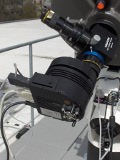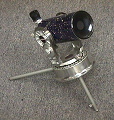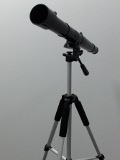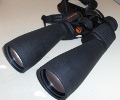Cahill Rooftop Observatory
Equipment for Check-Out
 Solar Filters
Solar Filters- We currently have solar observing filters sized for the C-14, the C-8, and the Questar, to allow everything from whole-Sun views at outreach events to in-depth study of sunspots. These filters are not included as part of the standard check-out for these telescopes and must be requested separately.
Since solar filters do not completely eliminate the risks of observing the Sun, we require that observers get safety training before checking out any of these filters.
Solar Observing Overview  SBIG ST-9E 512×512 Camera
SBIG ST-9E 512×512 Camera- The ST-9E camera is CRO's standard imager, intended for use in conjunction with the C-14. The default 1.4″ pixel scale slightly oversamples Pasadena seeing while allowing a modest 12′ field of view. A built-in guide chip allows for long exposures, provided a guide star is available near the target. We have successfully used the ST-9E to image the outer planets, star clusters, nebulae, and the brighter galaxies. The Moon and inner planets will saturate the detector, while low surface brightness galaxies are difficult to see against the light pollution foreground.
Camera SpecsDetailed Manual  14" f/11 Celestron
14" f/11 Celestron- This fully computerized instrument is the largest telescope we have at CRO. Mounting piers built into the roof protect the C-14 from vibrations and allow the German equatorial mount to be polar aligned almost instantly. This is the best telescope for CCD observing, but it supports our full selection of eyepieces and filters as well. All the planets except Mercury are within reach of the C-14, as are a variety of galaxies and nebulae. The Moon and some star clusters, however, are too large for the C-14 to see all at once. The C-14 may only be used from the rooftop and is not available for observing trips.
Telescope SpecsQuick Instructions Detailed Manual  10" f/13.5 Celestron
10" f/13.5 Celestron- We offer this telescope as an alternative to the C-14 for observers who don't want to bother with a complex GO-TO system or computer control. The C-10 comes with a fork mount, tracking drive, and a 8×40 finderscope, and can be used with all our 1.25" eyepieces and filters. It does not support 2" eyepieces or CCDs. All the planets are within reach of the C-10, as are a variety of galaxies and nebulae. The Moon and some star clusters, however, are too large for the C-10 to see all at once. The C-10 may only be used from the rooftop and is not available for observing trips.
Telescope SpecsQuick Instructions Detailed Manual  8" f/10 Celestron
8" f/10 Celestron- This is our most powerful portable telescope, but also our bulkiest; find a friend to help you carry it if you can. The C-8 comes with a fork mount, 6×30 finderscope, star diagonal, 2× Barlow lens, 40 mm (50×) eyepiece, and 17 mm (120×) eyepiece. The C-8 mount does not have a drive but can be tracked manually. All items except the mount should be in a single case; the mount is in two parts. This telescope can be used for most solar system targets, nearly all clusters, and the brighter nebulae.
Telescope SpecsQuick Instructions Detailed Manual  3.5" f/14.6 Questar
3.5" f/14.6 Questar- The Questar is an intermediate, wide-field telescope, more portable than the Celestron but more powerful than the Galileoscope. The Questar comes with a built-in fork mount, tracking drive, 2× Barlow lens, 26.6 mm (50×) eyepiece, and a 25mm (50×) reticle eyepiece, all of which should be in a single case. The Questar is well suited for lunar or open cluster observing, but gives adequate views of the planets as well.
Telescope SpecsQuick Instructions Detailed Manual  Two (2) 50 mm f/10 Galileoscopes
Two (2) 50 mm f/10 Galileoscopes- These telescopes were designed for education and outreach: they are light, easy to use, and even look like what most people imagine a telescope to be. Check-out includes a tripod, 2.5× Barlow lens, 20 mm (25×) eyepiece, and 30 mm (17×) eyepiece. Be forewarned that the 17× eyepiece is designed to mimic the equipment Galileo had, and is much more difficult to use than the modern 25× eyepiece. The Galileoscopes are best suited for the Moon or Jupiter.
Telescope SpecsQuick Instructions  Celestron 20-100×70 SkyMaster Binoculars
Celestron 20-100×70 SkyMaster Binoculars- The SkyMaster variable-zoom binoculars are the largest pair of binoculars we have at CRO. While they can be taken on trips like the UpClose binoculars, their weight makes it hard to point them accurately for long periods of time. If you have a sturdy tripod, you may wish to mount the binoculars and use them as a mini-telescope. They are well-suited for the Moon, planets, comets, and bright deep-sky objects.
 Two (2) Celestron 10×50 UpClose Binoculars
Two (2) Celestron 10×50 UpClose Binoculars- Our most portable instruments, the UpClose binoculars are great for observing trips out of town. They are well-suited for looking at the Moon, Jupiter, comets, star clusters, or the Milky Way. In dark skies they can even see the brightest nebulae and galaxies.
Telescope Reservations
Calendar abbreviations: Solar = Any solar filter; ST9E = CCD camera; C-14, C-10, or C-8 = 14", 10", or 8" Celestron, respectively; Q or Q3.5 = Questar; GS = Galileoscope; SM = SkyMaster binoculars; UC = UpClose binoculars.